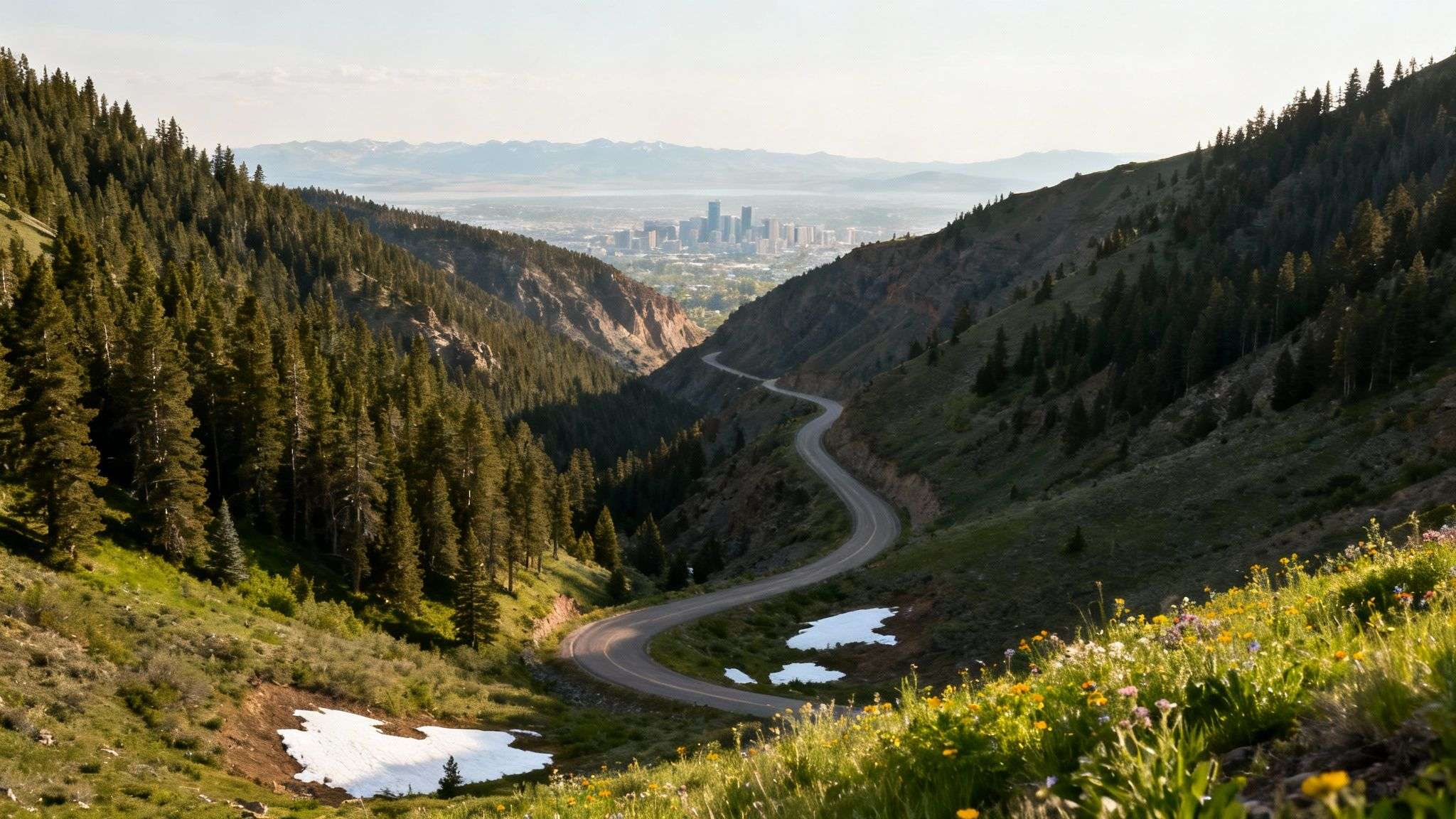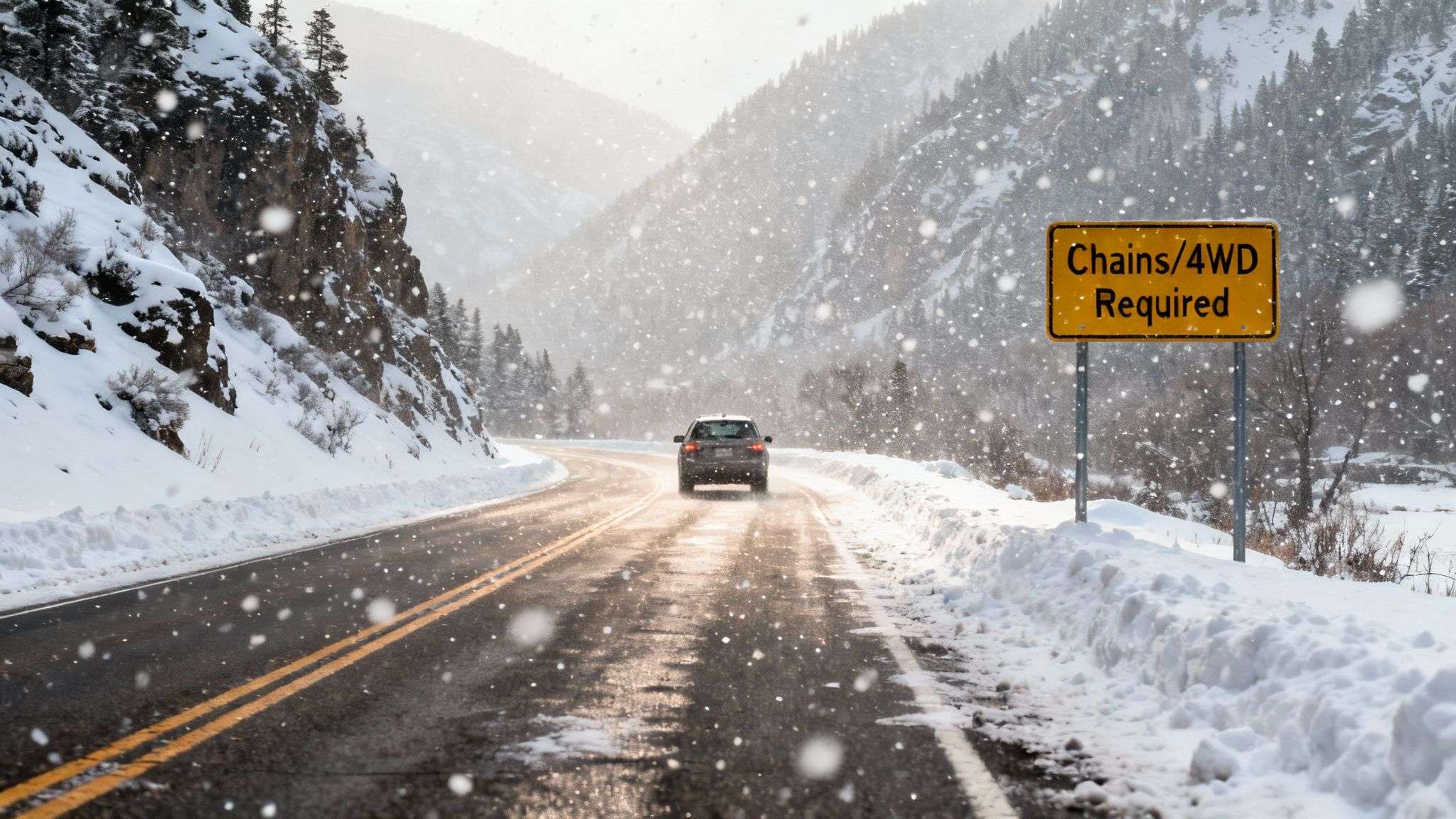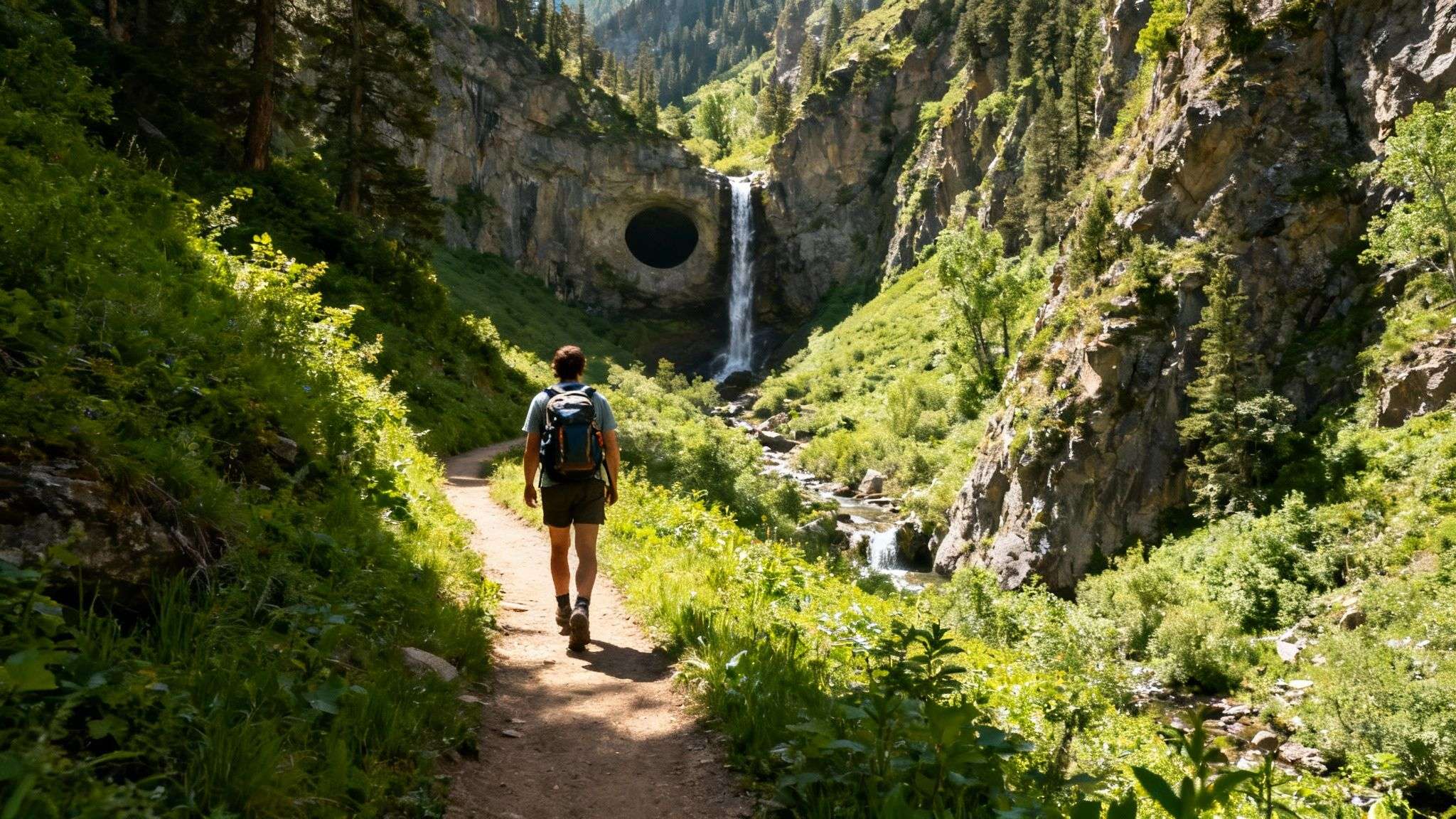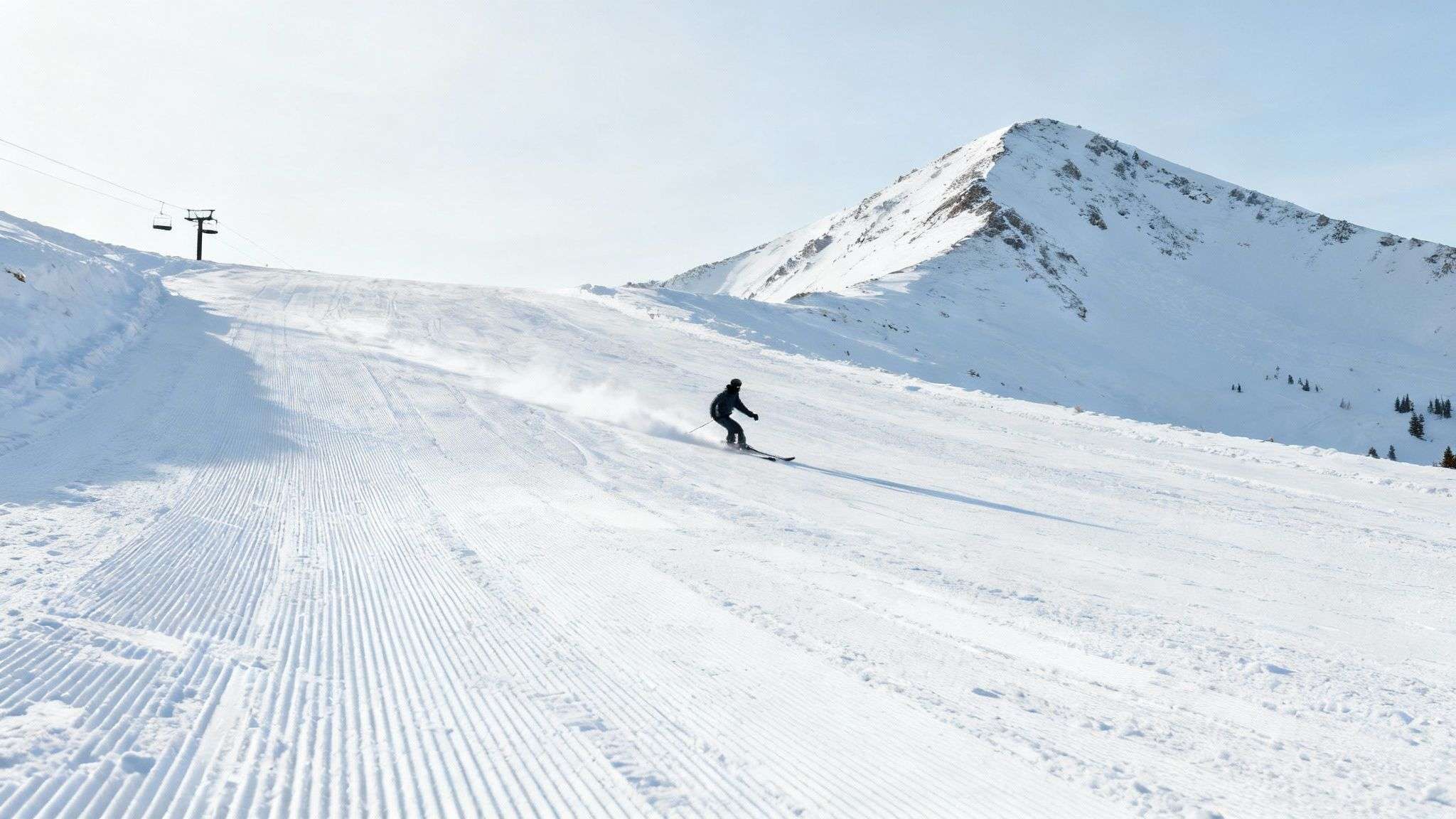Big Cottonwood Canyon Utah: A Complete Visitor Guide
Your guide to Big Cottonwood Canyon, Utah. Discover year-round activities, from skiing at Brighton and Solitude to summer hiking, plus essential tips on road conditions and watershed rules.
Just a quick drive from Salt Lake City, Big Cottonwood Canyon is a year-round mountain playground, home to world-class skiing in the winter and jaw-dropping hikes in the summer. This guide provides actionable tips for navigating the canyon, from understanding winter traction laws and beating traffic to finding the perfect trail for your adventure.
What is Big Cottonwood Canyon?
Stretching for 15 miles, Big Cottonwood Canyon is a stunning glacial trough carved into the Wasatch Range, offering endless room for adventure. Whether you're chasing deep powder at Brighton or Solitude or hiking through fields of vibrant wildflowers, understanding the canyon's seasonal rhythm is the key to planning a perfect trip.
One of the best things about Big Cottonwood is how close it is to Salt Lake City. On a clear day, you can get from downtown to the canyon mouth in 30 minutes, but that easy access has a downside: traffic. You absolutely need to plan ahead, especially on weekends and powder days.
Local Tip: Big Cottonwood Canyon is a critical protected watershed supplying drinking water to the Salt Lake Valley. That's why strict rules, like the ban on dogs, are enforced to keep the environment pristine. For anyone looking to lessen their environmental footprint, you can explore sustainable transportation solutions that help protect this incredible natural resource.
When is the Best Time to Visit?
Each season completely transforms the landscape, bringing its own unique activities and access rules. This seasonal breakdown will help you line up your plans with the right time of year, making sure you’re ready for whatever the canyon throws at you. For a live look at what's happening right now, our Big Cottonwood Canyon summary has real-time data on travel times and road status.
Big Cottonwood Canyon Seasonal Activity Guide
| Season | Typical Road Conditions | Primary Activities | Key Considerations |
|---|---|---|---|
| Winter (Dec-Mar) | Snow-covered; traction law often in effect. 4WD/AWD or chains required. | Skiing, snowboarding, snowshoeing, backcountry touring. | High avalanche danger; check forecasts daily. Heavy traffic on powder days. |
| Spring (Apr-Jun) | Varies; can be snowy at high elevations and clear at the bottom. Road to Guardsman Pass closed. | Late-season skiing, hiking lower-elevation trails, waterfall viewing. | Conditions change rapidly. Trails can be muddy or icy. |
| Summer (Jul-Sep) | Clear and fully accessible, including the Guardsman Pass Scenic Backway. | Hiking, rock climbing, mountain biking, fishing, picnicking. | Afternoon thunderstorms are common. Start hikes early. Watershed rules strictly enforced. |
| Fall (Oct-Nov) | Generally clear until the first major snowstorm. Guardsman Pass closes after the first snow. | Viewing fall foliage, hiking, biking. | Fewer crowds. Weather can be unpredictable. Prepare for colder temperatures. |

How to Get Around Big Cottonwood Canyon
Knowing your way up and down State Route 190—the canyon’s lifeline—is crucial, as conditions can flip on a dime. On a powder day, traffic can snake back for miles from the canyon's mouth, easily turning a 30-minute trip into a two-hour crawl. Planning ahead isn’t just a good idea; it's the difference between a great day and a frustrating one.

Understanding Winter Traction Laws
Winter in Big Cottonwood Canyon delivers "The Greatest Snow on Earth®," but it also comes with the mandatory Utah Traction Law. When this law is in effect, every vehicle heading up the canyon must be properly equipped for snow. You'll find law enforcement at the base of the canyon turning around any vehicle that doesn't meet the requirements. Here’s what you need:
- 4WD or AWD: Your vehicle must have tires marked with M+S (mud and snow) or the 3-peak mountain snowflake symbol.
- 2WD: Your vehicle needs proper snow tires on all four wheels, or you must use chains on the two drive wheels.
Ignoring the law will get you a fine and puts everyone on the road in a dangerous spot. Before you leave home, you can get a complete, real-time overview of Big Cottonwood Canyon conditions, including traction law status, traffic, and any active alerts.
Beating Traffic and Parking Hassles
On a busy winter weekend or powder day, parking lots at both Brighton and Solitude can fill up before the lifts even start turning. The UTA Ski Bus is your best bet for sidestepping the infamous canyon traffic and the inevitable parking nightmare.
Here's why taking the bus is a game-changer:
- No Parking Worries: Get dropped off right at the base area.
- Cost Savings: It’s often cheaper than burning gas to sit in traffic.
- Safety: The buses are built for winter roads and driven by pros.
Always check the UTA website for the latest routes, schedules, and fares. Taking the bus not only makes your day easier but also helps reduce congestion.
What to Do in Big Cottonwood Canyon

Summer: Hiking, Biking, and Climbing
Once the snow recedes, Big Cottonwood Canyon Utah sheds its winter coat and explodes into a green paradise. From a quick family stroll to a grueling alpine climb, there’s an adventure here for absolutely everyone.
Top Hiking Trails For Every Ability
- Beginner (Donut Falls Trail): This short, 1.5-mile roundtrip hike is a classic for a reason. It's mostly flat and leads to a unique waterfall that pours through a hole in the rock.
- Intermediate (Desolation Lake Trail): This 7.7-mile roundtrip hike takes you through peaceful aspen groves and wildflower meadows to a secluded, pristine lake.
- Advanced (Lake Blanche Trail): This is one of the most iconic—and demanding—hikes in the Wasatch. The 7-mile roundtrip trail is relentlessly steep, gaining 2,700 feet, but the payoff is a jaw-dropping view of Sundial Peak.
Rock Climbing And Bouldering
Big Cottonwood Canyon is a world-class climbing destination, famous for its grippy quartzite crags. Popular areas include the S-Curve, Dogwood Crag, and Stairs Gulch. Bouldering is also huge here, with thousands of established problems scattered all over the canyon floor.
Local Tip: Afternoon thunderstorms are no joke in the Wasatch and can roll in fast. Get an early start to give yourself the best shot at a safe, storm-free day on the trail or the rock.
Essential Summer Rules
Most importantly, the entire canyon is a protected watershed. This means no dogs are allowed anywhere in the canyon—no exceptions. The rule is strictly enforced with hefty fines. Always pack out everything you pack in and stay on designated trails.
Winter: Skiing and Snowboarding
Big Cottonwood Canyon is legendary for its claim to "The Greatest Snow on Earth®," and at the heart of this powder paradise are two iconic ski resorts: Brighton and Solitude. While they’re neighbors sharing the same incredible snow, they offer two different vibes.

Brighton vs. Solitude
- Brighton Resort: Sitting at the top of the canyon, Brighton has a relaxed, local's feel. It's famous for its awesome terrain parks, extensive night skiing, and a killer deal where kids 10 and under ski free.
- Solitude Mountain Resort: Just down the road, Solitude offers a more polished experience with amazing amenities and seriously challenging expert terrain, including the legendary Honeycomb Canyon.
For a deeper dive, check out our guide to Big Cottonwood Canyon ski resorts for more local intel.
Lift Tickets And Rentals
Both Brighton and Solitude are on the Ikon Pass. If you're buying single-day tickets, always buy them online ahead of time to save money and avoid sellouts. You can rent gear at the resorts, but stopping at a ski shop in Salt Lake City on your way up can save you time and money.
Local Tip: Grab your rental gear the afternoon before you ski. Most shops will let you do this, so you can skip the morning rental line and head straight for the lift.
Backcountry Safety
Big Cottonwood is a world-class backcountry destination, but it's also incredibly dangerous without proper training and gear. Before venturing out, you must have an avalanche beacon, shovel, and probe, know how to use them, and check the daily forecast from the Utah Avalanche Center (UAC).
The History of Big Cottonwood Canyon
Today, Big Cottonwood Canyon is an outdoor playground, but it was once the heart of an intense industrial boom of logging and mining that left it scarred and stripped bare. Recognizing the damage, Salt Lake City and the U.S. Forest Service teamed up in 1910 for a pioneering reforestation project, establishing the Wasatch Nursery at what is now Spruces Campground. The lush forests we enjoy today are the direct result of this historic conservation effort. You can dive deeper into the history of the Cottonwood Canyons' development.
Frequently Asked Questions
Are Dogs Allowed In Big Cottonwood Canyon?
No, dogs are not allowed in Big Cottonwood Canyon. The entire canyon is a protected watershed that supplies drinking water to the Salt Lake Valley. This is strictly enforced with steep fines.
Do I Need a 4x4 for the Canyon in Winter?
Not always, but your vehicle must meet traction law requirements whenever they’re active. When UDOT puts the traction law in effect, you need either a 4WD/AWD vehicle with snow-rated tires or a 2WD vehicle with snow tires or chains. Always check the live UDOT traffic site before you leave.
When Is the Best Time to See Wildflowers?
Your best bet is generally from early July through mid-August. The exact timing depends on the winter’s snowpack and elevation, but the trails around Brighton and Guardsman Pass typically have the most spectacular displays in late July.
Before you head up the canyon, get the most current travel information with Wasatch Travel Helper. Our live data on traffic, road conditions, and resort status helps you plan the perfect day in the mountains. Visit us at https://wasatchroads.com to travel smarter.